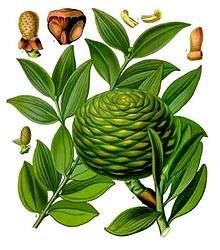Agathis dammara
Agathis dammara, commonly known as the Amboyna pine or almaciga (almasiga), is a coniferous timber[1] tree native to the Philippines and to Sumatra, Java, Borneo, Sulawesi, and the Maluku Islands in Indonesia.
| Agathis dammara | |
|---|---|
 | |
| Scientific classification | |
| Kingdom: | Plantae |
| Clade: | Tracheophytes |
| Division: | Pinophyta |
| Class: | Pinopsida |
| Order: | Pinales |
| Family: | Araucariaceae |
| Genus: | Agathis |
| Species: | A. dammara |
| Binomial name | |
| Agathis dammara | |
| Synonyms | |
| |
Description
_West-Preanger_TMnr_60051135.jpg)
Agathis dammara is a medium-large conifer up to 60 metres in height found in tropical rainforests, growing from sea level to very high mountainous regions where it becomes extremely stunted. It belongs to the southern hemisphere family Araucariaceae, widespread throughout the entire Mesozoic, emerging about 200 million years ago. An extinct genus, Protodammara (which appeared long ago, during the Mesozoic), derives its name from this tree. This tree is a source of dammar gum, also known as cat-eye resin.
Taxonomy
When first discovered and listed as a species it was placed in the genus Pinus (Lambert, 1803), and then later with the firs, Abies (Poir 1817), and then with its own genus, Dammara. It was first recognised as being part of Agathis in 1807, when it was listed as Agathis loranthifolia, and beyond that with species names beccarii, celebica and macrostachys, although it acquired many more names before dammara was settled on.
Related species
Agathis is a very diverse genus, although it has only 21 species. Many Agathis species are found in tropical rainforests, some other species grow in more temperate and cool climate forests. Agathis atropurpurea is found in montane forests of far northern Queensland, Australia. The species grows in regions with altitudes between 950–1450 metres above sea-level. Where rainfall could exceed 18,000 millimetres in areas with no data. In the cloud forest of this region, the soil is so deprived of nutrients, that trees cannot grow in some areas; leaving only heathland and sphagnum bogs. Agathis robusta grows in tropical rainforests on sandy soils near the coast, such as on Fraser Island where it grows in subtropical rainforest (although there is no soil on Fraser Island, only sand). Agathis ovata grows at altitudes between 150–1000 metres in New Caledonia, sometimes in forests, sometimes in open scrubland.
References
- Agathis wood Archived April 1, 2010, at the Wayback Machine
External links
| Wikispecies has information related to Agathis dammara |
| Wikimedia Commons has media related to Agathis dammara. |
- Agathis dammara at the Gymnosperm Database.
- "Agathis dammara". Germplasm Resources Information Network (GRIN). Agricultural Research Service (ARS), United States Department of Agriculture (USDA).